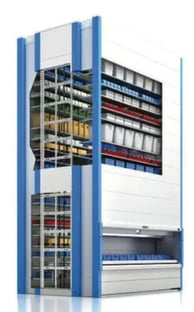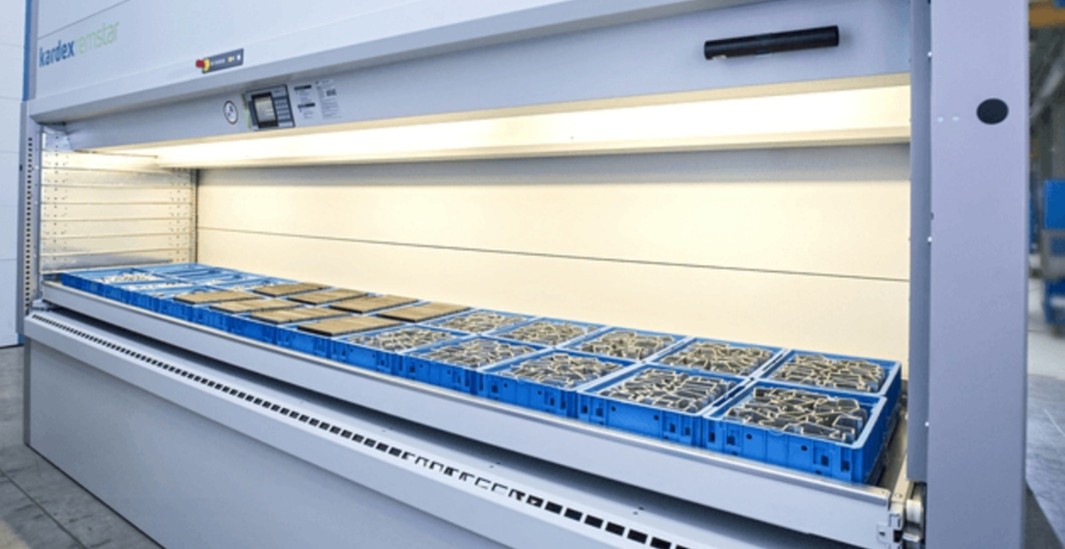A Vertical Lift Module (VLM) is a high-density automated storage and retrieval system categorized as Goods to Person automation. Goods to Person systems bring the product to the picker who remains in a small footprint. These systems utilize the vertical height of a facility and will automatically retrieve and putaway the storage trays based on the logic within the onboard software. VLM software allows a worker to scan individual orders and retrieve the product for that order. Or to scan a batch of orders and the system will present all the trays needed to satisfy the batch, one right after the other.
Vertical Lift Modules are fully enclosed, consisting of a series of trays that sit one on top of another in a stack on the front half, and the back half of the unit. An elevator runs vertically up and down the center of the unit, pulling trays from storage and presenting them to a worker at the front of the unit.
another in a stack on the front half, and the back half of the unit. An elevator runs vertically up and down the center of the unit, pulling trays from storage and presenting them to a worker at the front of the unit.
VLMs are ideal for a wide range of applications and operations – from storing critical spare parts to picking of orders for ecommerce businesses. And because the worker only moves in the space that is the width of the VLM, there is limited walking involved compared to conventional picking - one of the strongest benefits of VLMs. This Goods to Person technology drives down labor costs in operations.
How Does a Vertical Lift Module Work?
As mentioned before, the basis for all VLMs is an internal series of trays stacked on the backside and on the front of each unit. These metal trays can be configured in a variety of ways based on the manufacturer. Typically, VLM trays are generally a maximum of 30” to 40” in depth and can be as wide as 12 feet to 13 feet wide depending on the manufacturer. Smaller units can be configured as well to suit the products and space they will be consuming in a facility.
Each tray can either utilize a series of dividers supplied by a manufacturer; or use plastic totes on the tray; or even master cases that products are stocked in. A tray could easily accommodate hundreds of stock locations for small cube parts and inventory.

From a height perspective, Vertical Lift Modules can maximize the clear height of your facility with some manufacturers offering units more than 50 feet high. To maximize this space, typically a laser is used to determine the maximum product height on each tray as it leaves the worker. When a tray is put away, the height is measured to ensure that it is placed in a location that can accommodate the height of the product on the tray. This also minimizes excess space in a facility by tightly fitting trays in the system, one right on top of the other eliminating “honey-combing” space in conventional racking.
Interested in receiving multiple bids for VLMs in Your Operations?
An elevator travels the center channel, both retrieving and putting away trays in the unit. The elevator is called up by either scanning a picking document or recalling a tray by manually entering a SKU number that needs to be retrieved from the VLM. The unit is extremely fast and accurate for storing and retrieving goods.
From a weight perspective, VLMs can support a diverse range of goods, with manufacturers having a capacity for low weight products like spare parts to over 2,000 pounds per tray depending on what is being stored.
By stacking the trays vertically, Vertical Lift Modules offer a significantly higher storage density, and will maximize the vertical height in a facility better than most other storage options. Consider that a large VLM will have a footprint roughly 13 feet wide by 10 feet deep yet can store hundreds or even thousands of parts in those 130 square feet. This is almost impossible to achieve with any other storage system.
VLM manufacturers offer various aids to assist workers, thus improving efficiencies and accuracies. These typically include:
- With “pick and put to light” technology, manufacturers utilize light bars that visually identify the location the worker is to pick from or putaway product to.
- In conjunction with the light bar, some VLM manufacturers offer a laser that will illuminate the bin location to be picked from or put product away to.
- A display that will reflect an image of the product to be pulled along with other product specifications.
- Products can be scanned to further increase the accuracy of the picks.
With robust engineering and software design, VLMs maximize the facility footprint and increase throughput and accuracy. Depending on the types of products, the product characteristics, and proper slotting, workers can achieve a much higher level of productivity and accuracy than conventional picking methods. When utilizing a pod of VLMs working in conjunction with each other, depending on the product and cubic characteristics, workers can achieve 400 to 500 lines per hour. There are many ways to configure systems and operational differences between manufacturers. An objective warehouse consultant can assist with ensuring you end up with the right VLMs to achieve the return on investment.





SHARE